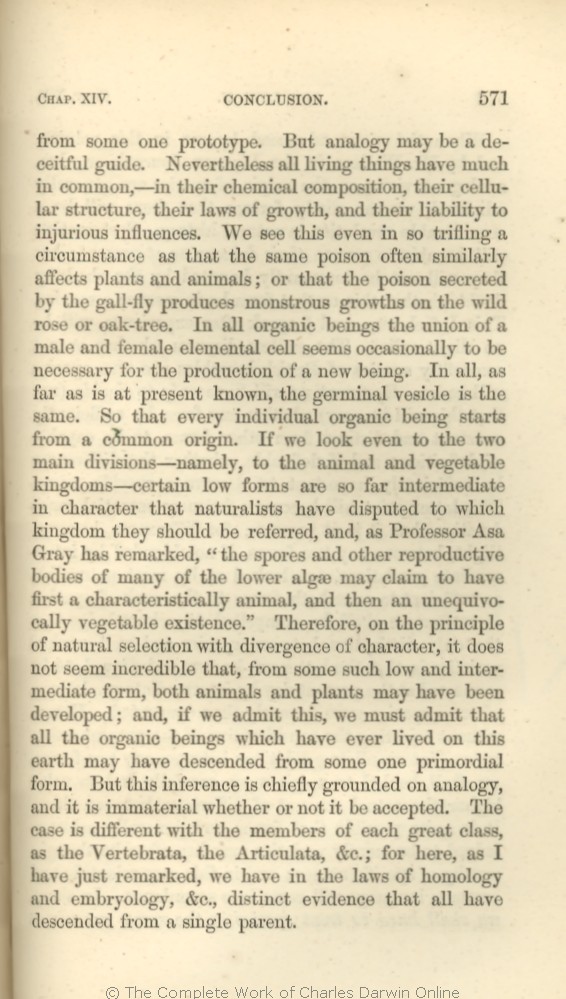from some one prototype. But analogy may be a deceitful guide. Nevertheless all living things have much in
common,— | common,— 1861 1866 1869 | | common, 1859 1860 1872 |
| OMIT 1861 1866 1869 1872 |
| germinal vesicles, their 1859 1860 |
| ..... 1861 1866 1869 1872 | | and 1859 1860 |
| growth, 1861 1866 1869 1872 | | growth 1859 1860 |
| their liability to injurious influences. 1861 1866 1869 1872 |
| reproduction. 1859 1860 |
| circumstance 1859 1860 1861 1866 | | fact 1869 1872 |
| gall-fly 1859 1860 1861 1866 1872 | | gallfly 1869 |
| 1 blocks not present in 1859 1860 1861 1866 1869; present in 1872 | | With all organic beings, excepting perhaps some of the very lowest, sexual reproduction seems to be essentially similar.
|
| In 1861 1866 | | With 1869 1872 |
| all, 1861 1866 1872 | | all 1869 |
| as far as is at present known, the germinal vesicle is the same. 1861 1866 |
| organic beings sexual reproduction seems to be essentially similar. 1869 |
| as far as is at present known, the germinal vesicle is the same; 1872 |
| So that every individual organic being 1861 1866 |
| With all, as far as is at present known, the germinal vesicle is the same; so that all organisms 1869 |
| so that all organisms 1872 |
| starts 1861 1866 | | start 1869 1872 |
| animal 1861 1866 1872 | | animal, 1869 |
| referred, 1861 1866 1869 | | referred. 1872 |
| and, as 1861 1866 1869 | | As 1872 |
| algæ 1861 1866 1872 | | algæ? 1869 |
| Therefore, 1861 1866 1869 1872 | | Therefore 1859 1860 |
| on the principle of natural selection with divergence of character, it does not seem incredible that, 1861 1866 1869 1872 |
| I should infer from analogy that probably all the organic beings which have ever lived on this earth have descended 1859 1860 |
| such low and intermediate form, both animals and plants may have been developed; and, if we admit this, we must admit that all the organic beings which have ever lived on this earth may have descended from some one 1861 1866 |
| one 1859 1860 |
| such low and intermediate form, both animals and plants may have been developed; and, if we admit this, we must likewise admit that all the organic beings which have ever lived on this earth may be descended from some one 1869 1872 |
| form. 1861 1866 1869 1872 | | form, 1859 1860 |
| ..... 1861 1866 1869 1872 | | into 1859 1860 |
| ..... 1861 1866 1869 1872 | | which 1859 1860 |
| ..... 1861 1866 1869 1872 | | life 1859 1860 |
| ..... 1861 1866 1869 1872 | | was 1859 1860 |
| ..... 1861 1866 1869 1872 | | first 1859 1860 |
| OMIT 1861 1866 1869 1872 |
| breathed. 1859 |
| breathed by the Creator. 1860 |
| I have just 1866 |
| has just been 1861 |
|









